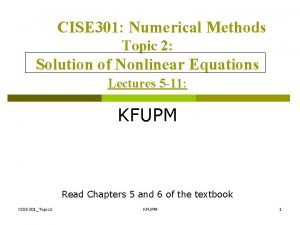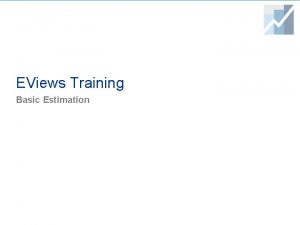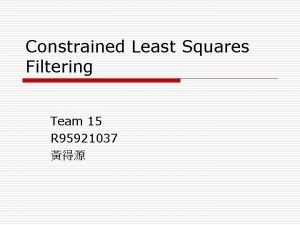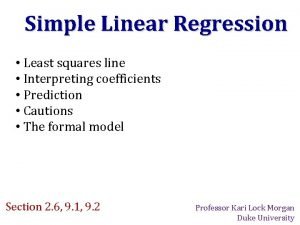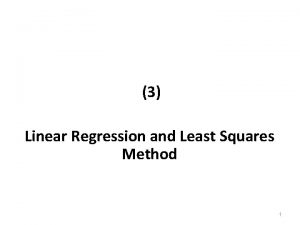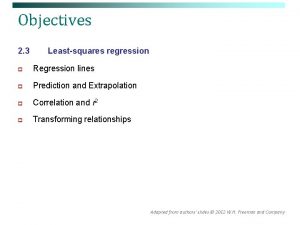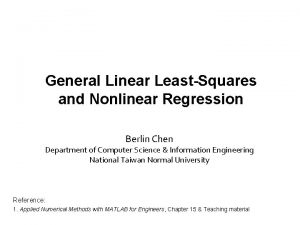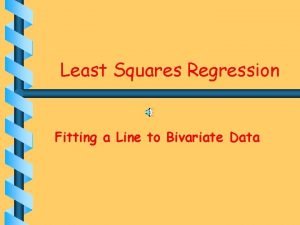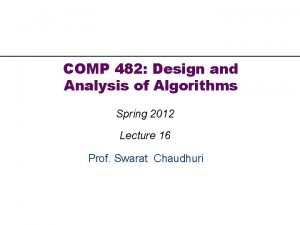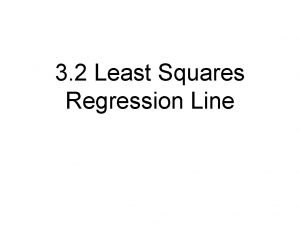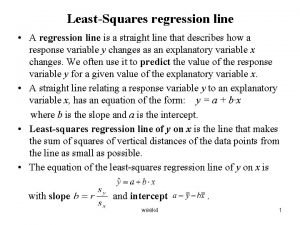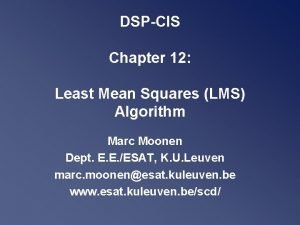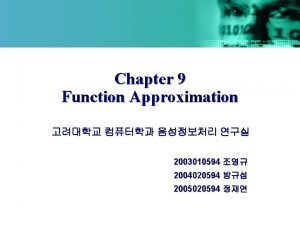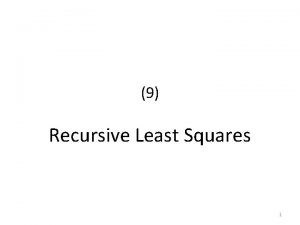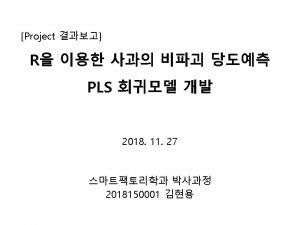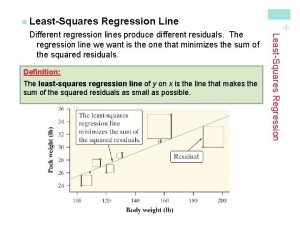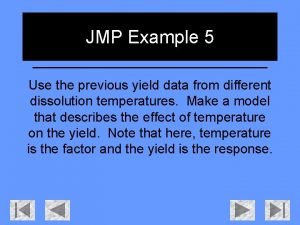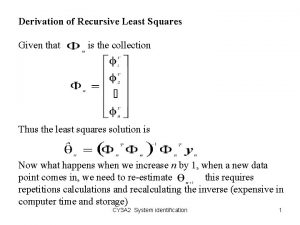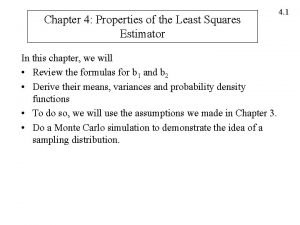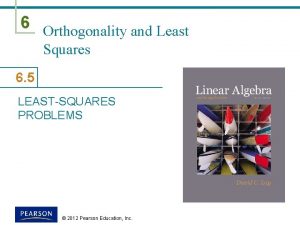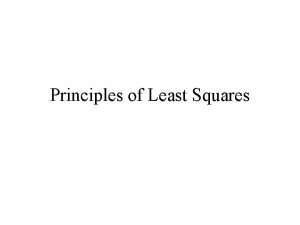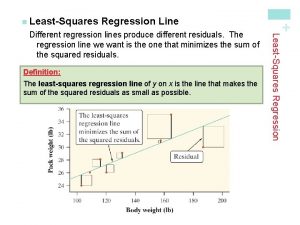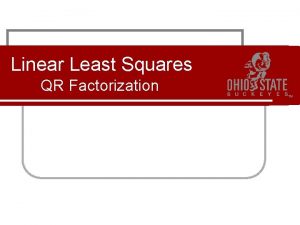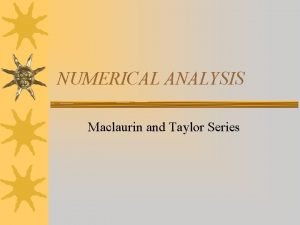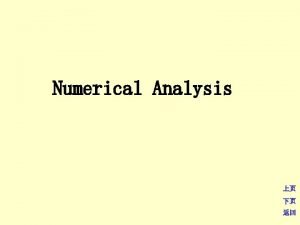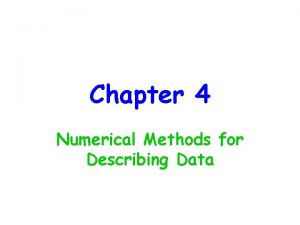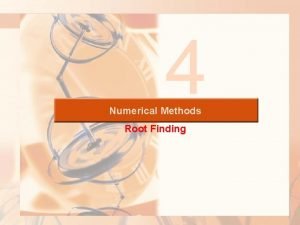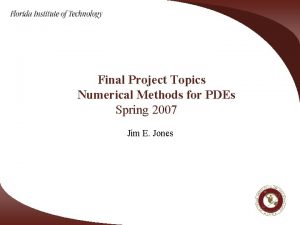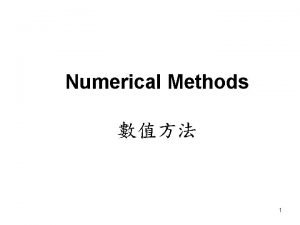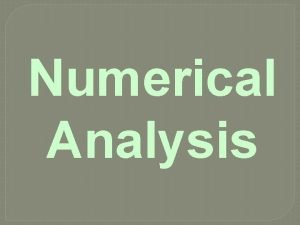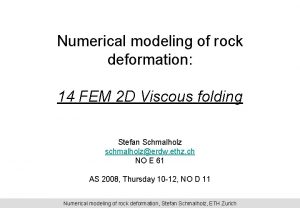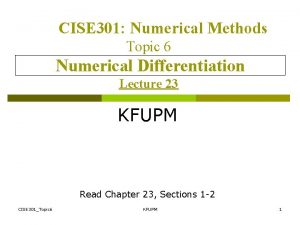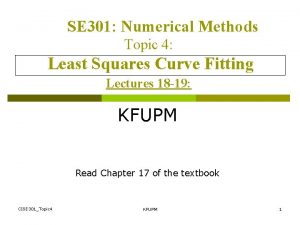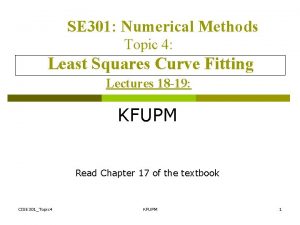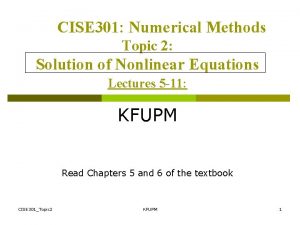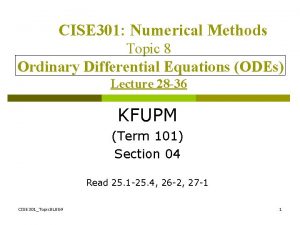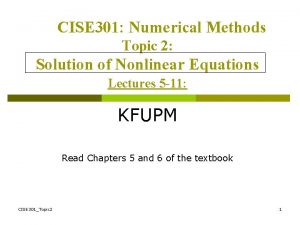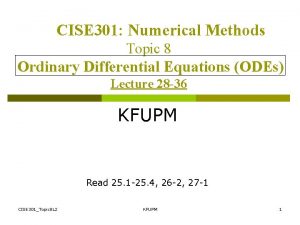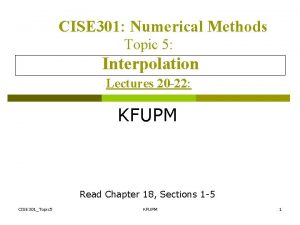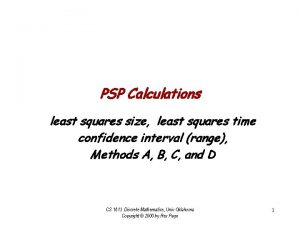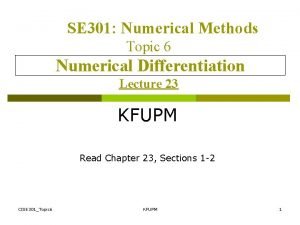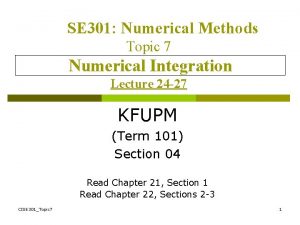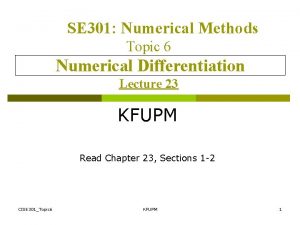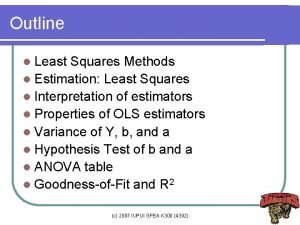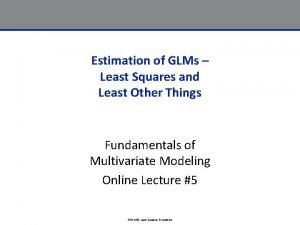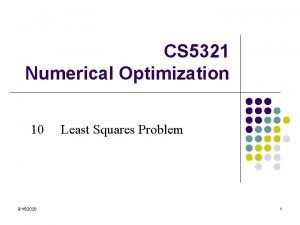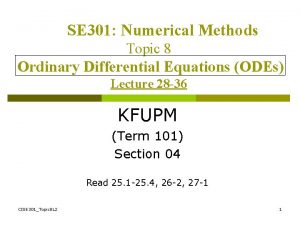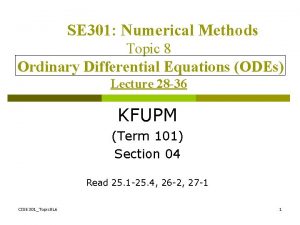CISE 301 Numerical Methods Topic 4 Least Squares







































- Slides: 39

CISE 301: Numerical Methods Topic 4: Least Squares Curve Fitting Lectures 18 -19: KFUPM Read Chapter 17 of the textbook CISE 301_Topic 4 1

Lecture 18 Introduction to Least Squares CISE 301_Topic 4 2

Motivation Given a set of experimental data: x 1 2 3 y 5. 1 5. 9 6. 3 • The relationship between x and y may not be clear. • Find a function f(x) that best fit the data CISE 301_Topic 4 1 2 3 3

Motivation p In engineering, two types of applications are encountered: n n 1. 2. Trend analysis: Predicting values of dependent variable, may include extrapolation beyond data points or interpolation between data points. Hypothesis testing: Comparing existing mathematical model with measured data. What is the best mathematical function f that represents the dataset? What is the best criterion to assess the fitting of the function f to the data? CISE 301_Topic 4 4

Curve Fitting Given a set of tabulated data, find a curve or a function that best represents the data. Given: 1. The tabulated data 2. The form of the function 3. The curve fitting criteria Find the unknown coefficients CISE 301_Topic 4 5

Least Squares Regression Linear Regression p Fitting a straight line to a set of paired observations: (x 1, y 1), (x 2, y 2), …, (xn, yn). y=a 0+a 1 x+e a 1 -slope. a 0 -intercept. e-error, or residual, between the model and the observations. CISE 301_Topic 4 6

Selection of the Functions CISE 301_Topic 4 7

Decide on the Criterion Chapter 17 Chapter 18 CISE 301_Topic 4 8

Least Squares Regression Given: xi x 1 x 2 …. xn yi y 1 y 2 …. yn The form of the function is assumed to be known but the coefficients are unknown. The difference is assumed to be the result of experimental error. CISE 301_Topic 4 9

Determine the Unknowns CISE 301_Topic 4 10

Determine the Unknowns CISE 301_Topic 4 11

Determining the Unknowns CISE 301_Topic 4 12

Normal Equations CISE 301_Topic 4 13

Solving the Normal Equations CISE 301_Topic 4 14

Example 1: Linear Regression CISE 301_Topic 4 x 1 2 3 y 5. 1 5. 9 6. 3 15

Example 1: Linear Regression CISE 301_Topic 4 i 1 2 3 sum xi yi 1 5. 1 2 5. 9 3 6 17. 3 x i 2 1 4 9 14 xi y i 5. 1 11. 8 18. 9 35. 8 16

Multiple Linear Regression Example: Given the following data: t 0 1 x 0. 1 0. 4 0. 2 y 3 2 2 1 3 2 Determine a function of two variables: f(x, t) = a + b x + c t That best fits the data with the least sum of the square of errors. CISE 301_Topic 4 17

Solution of Multiple Linear Regression Construct , the sum of the square of the error and derive the necessary conditions by t 0 1 2 3 x 0. 1 0. 4 0. 2 y 3 2 1 2 equating the partial derivatives with respect to the unknown parameters to zero, then solve the equations. CISE 301_Topic 4 18

Solution of Multiple Linear Regression CISE 301_Topic 4 19

System of Equations CISE 301_Topic 4 20

Example 2: Multiple Linear Regression i ti xi yi x i 2 x i ti xi y i ti 2 ti y i CISE 301_Topic 4 1 0 0. 1 3 2 1 0. 4 2 3 2 0. 2 1 4 3 0. 2 2 Sum 6 0. 9 8 0. 01 0 0. 3 0 0 0. 16 0. 4 0. 8 1 2 0. 04 0. 2 4 2 0. 04 0. 6 0. 4 9 6 0. 25 1. 4 1. 7 14 10 21

Example 2: System of Equations CISE 301_Topic 4 22

Lecture 19 Nonlinear Least Squares Problems p p p Examples of Nonlinear Least Squares Solution of Inconsistent Equations Continuous Least Square Problems CISE 301_Topic 4 23

Polynomial Regression p The least squares method can be extended to fit the data to a higher-order polynomial CISE 301_Topic 4 24

Equations for Quadratic Regression CISE 301_Topic 4 25

Normal Equations CISE 301_Topic 4 26

Example 3: Polynomial Regression Fit a second-order polynomial to the following data xi 0 1 2 3 4 5 ∑=15 yi 2. 1 7. 7 13. 6 27. 2 40. 9 61. 1 ∑=152. 6 x i 2 0 1 4 9 16 25 ∑=55 x i 3 0 1 8 27 64 125 225 x i 4 0 1 16 81 256 625 ∑=979 xi y i 0 7. 7 27. 2 81. 6 163. 6 305. 5 ∑=585. 6 x i 2 y i 0 7. 7 54. 4 244. 8 654. 4 1527. 5 ∑=2488. 8 CISE 301_Topic 4 27

Example 3: Equations and Solution CISE 301_Topic 4 28

How Do You Judge Functions? CISE 301_Topic 4 29

is preferable than Linear Regression y y x Linear Regression CISE 301_Topic 4 x Quadratic Regression 30

Fitting with Nonlinear Functions xi 0. 24 0. 65 0. 95 1. 24 1. 73 2. 01 2. 23 2. 52 yi 0. 23 -1. 1 -0. 45 0. 27 0. 1 -0. 29 0. 24 CISE 301_Topic 4 31

Fitting with Nonlinear Functions CISE 301_Topic 4 32

Normal Equations CISE 301_Topic 4 33

Example 4: Evaluating Sums xi 0. 24 0. 65 0. 95 1. 24 1. 73 2. 01 2. 23 2. 52 ∑=11. 57 yi 0. 23 -1. 1 -0. 45 0. 27 0. 1 -0. 29 0. 24 ∑=-1. 23 (ln xi)2 2. 036 0. 1856 0. 0026 0. 0463 0. 3004 0. 4874 0. 6432 0. 8543 ∑=4. 556 ln(xi) cos(xi) -1. 386 -0. 3429 -0. 0298 0. 0699 -0. 0869 -0. 2969 -0. 4912 -0. 7514 ∑=-3. 316 ln(xi) * exi -1. 814 -0. 8252 -0. 1326 0. 7433 3. 0918 5. 2104 7. 4585 11. 487 ∑=25. 219 yi * ln(xi) -0. 328 0. 0991 0. 0564 -0. 0968 0. 1480 0. 0698 -0. 2326 0. 2218 ∑=-0. 0625 cos(xi)2 0. 943 0. 6337 0. 3384 0. 1055 0. 0251 0. 1808 0. 3751 0. 6609 ∑=3. 26307 cos(xi) * exi 1. 235 1. 5249 1. 5041 1. 1224 -0. 8942 -3. 1735 -5. 696 -10. 104 ∑=-14. 481 yi*cos(xi) 0. 223 -0. 1831 -0. 6399 -0. 1462 -0. 0428 -0. 0425 0. 1776 -0. 1951 ∑=-0. 8485 (exi)2 1. 616 3. 6693 6. 6859 11. 941 31. 817 55. 701 86. 488 154. 47 ∑=352. 39 yi * exi CISE 301_Topic 4 0. 2924 -0. 4406 -2. 844 -1. 555 1. 523 0. 7463 -2. 697 2. 9829 ∑=-1. 9923 34

Example 4: Equations & Solution CISE 301_Topic 4 35

Example 5 Given: xi 1 2 3 yi 2. 4 5 9 Difficult to Solve CISE 301_Topic 4 36

Linearization Method CISE 301_Topic 4 37

Example 5: Equations CISE 301_Topic 4 38

Evaluating Sums and Solving xi 1 2 3 yi 2. 4 5 9 zi=ln(yi) 0. 875469 1. 609438 2. 197225 ∑=4. 68213 x i 2 1 4 9 ∑=14 xi zi 0. 875469 3. 218876 6. 591674 ∑=10. 6860 CISE 301_Topic 4 ∑=6 39
 Cise 301
Cise 301 Youcubed squares and more squares answers
Youcubed squares and more squares answers Damien thiesson
Damien thiesson Heteroskedasticity eviews
Heteroskedasticity eviews Constrained least square filter
Constrained least square filter Least squares regression
Least squares regression Least squares model
Least squares model Least squares regression line statcrunch
Least squares regression line statcrunch Regression berlin
Regression berlin Bivariate least squares regression
Bivariate least squares regression Segmented least squares dynamic programming
Segmented least squares dynamic programming Least squares regression line
Least squares regression line How to find lsrl
How to find lsrl Least squares regression line minitab
Least squares regression line minitab Least mean squares
Least mean squares Continuous least squares approximation
Continuous least squares approximation Recursive least squares example
Recursive least squares example Linear least squares regression
Linear least squares regression Least squares regression line definition
Least squares regression line definition Least square solution
Least square solution Polynomial regression least squares
Polynomial regression least squares Fit least squares jmp
Fit least squares jmp Recursive least squares python
Recursive least squares python Properties of least square estimates
Properties of least square estimates Orthogonality and least squares
Orthogonality and least squares What are the principles of least squares?
What are the principles of least squares? Least squares regression line definition
Least squares regression line definition Qr factorization least squares
Qr factorization least squares Taylor series numerical methods
Taylor series numerical methods Interpolation in numerical methods
Interpolation in numerical methods Chronicle of higher education
Chronicle of higher education Birge-vieta method is used to find
Birge-vieta method is used to find Graphical and numerical methods
Graphical and numerical methods Different types of errors in numerical methods
Different types of errors in numerical methods Numerical methods final project
Numerical methods final project Numerical methods of descriptive statistics
Numerical methods of descriptive statistics Numerical methods
Numerical methods Newton backward interpolation formula
Newton backward interpolation formula Numerical methods
Numerical methods Numerical methods for partial differential equations eth
Numerical methods for partial differential equations eth
